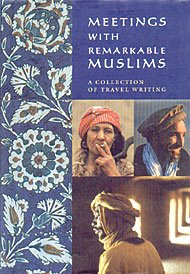How many remarkable Muslims have you met?
 Lisa Kaaki
Lisa Kaaki Special to Arab News Review
Since 9/11 there has been an international interest in the Islamic world which has continued to the present. One of the latest efforts to shed some new light on Muslims comes in the form of a delightful book: “Meetings With Remarkable Muslims, a Collection of Travel Writing.”
The idea for the book came after the editors, Barnaby Rogerson and Rose Baring, witnessed the marches in London protesting against the invasion of Iraq: “Realizing that the lies, half-truths and manufactured fears by which this war had been sold to the public were backed by the images of the Islamic world latched onto by our media — of bearded fanatics, suicide bombers and veiled gunmen — it seemed important to offer a broader, truer picture. As anyone who has traveled regularly within the Muslim world will know, this perception is willfully, even perhaps maliciously, false. “
The collection is divided into three parts, “Here and Now,” “Memories,” and “Ghosts,” in which the authors show the lives of Muslims, highlighting the varieties of their practices and traditions. The book is more than anything about ordinary Muslims leading ordinary lives: “There are no world-famous presidents, revolutionary colonels, or publicity-hungry preachers in this world-view. Instead it is the porters, drivers, smugglers, musicians, teachers, mothers, neighbors and restaurateurs who are cherished for the example of their ordinary lives,” say the authors.
Although most of the writers in this collection would not describe themselves as writers at all, the pieces are beautifully written. Alberto Cairo, a lawyer by profession, has been making prosthetic arms and legs in Kabul for the past fifteen years. In 1996, he was described on the front page of the International Herald Tribune as “the most beloved foreigner in Afghanistan.” His personal account of life in Kabul is of a country still searching for peace: “In Kabul new restaurants and pizzerias are opening all the time with exotic foreign names such as Golden Lotus, The Great Wall, New York Restaurant; the cinemas show romantic Indian films with songs and violence; you see mobile phones everywhere, the traffic is chaotic, much of the city is a building site, refugees have returned in their thousands. Life seems to be surging ahead triumphantly. But peace has not yet spread through the land. “
In another piece, Robin Hanbury-Tenison writes about his life with his Tuareg companions when they wandered through the northern Air Mountains, a part of the Sahara few outsiders have ever visited — or even know about. In a moving account of his travels, he praises his companions who “would die rather than let anything happen to me... In my whole life I have never felt safer, more wrapped in friendship. “
Brigid Keenan, a diplomat’s wife who has lived in Muslim countries for more than ten years, was impressed by Thala Khair, “the daughter-in-law of a Syrian Defense Minister and the wife of a colonel in the Syrian Republican Guard; she doesn’t sound like an obvious choice but that’s one reason I decided on her; she goes against all the stereotypes — of Syrians, and of women in the Arab world” writes Keenan.
Eamonn Gearon learnt the traditional skills for living and traveling in the desert and later moved to the oasis of Siwa where he lived eighteen months and befriended Muhammad: “I was lucky to have him as my friend when I lived in the oasis... Since Sept. 11, 2001, I have thought a great deal about jihad, and my friend Muhammad whose example showed what it means to be a jihadi. As surely as jihad can mean fighting the enemy without, so must it also be understood as the fight against the enemy within, fighting the urge to sin, and through introspection trying to defeat evil. It is in this way that the believer wages jihad daily. To fight the good fight.” writes Gearon.
One of the most moving stories of the book is told by William Dalrymple, author of the much praised “White Mughals.” Presently living in New Delhi, Dalrymple writes about his meeting with Dr Jaffrey, a scholar who converted an often illegible manuscript which was a court chronicle of Shah Jehan into clear Persian typescript, and then had it translated into English by a team of Persian scholars in America. The manuscript deals with the golden age of the Mughals when India, Pakistan and parts of Afghanistan were ruled from the Red Fort in Delhi.
From his small, dark room in the heart of Old Delhi, Dr Jaffrey speaks about changing times: “Today there are no longer any educated men in the old city. I am a stranger in my own home... All the learning, all the manners have gone... Everything is so crude now. Here everyone has forgotten the old courtesies. For example... in the old days, a man of my standing would never have gone to the shops — everything would be sent to his house: Grain, chilies, cotton, cloth. All these things have gone now. People see the educated man living in poverty and realize that learning is useless; they decide it is better to remain ignorant.” But more than his knowledge and devotion to his scholarly work, it is Dr. Jaffrey’s faith which impresses Dalrymple. When Dalrymple confesses that he is no longer sure what he believes in, Dr. Jaffrey tells him: “You make God sound so complicated. God is simple. To follow him is not difficult.
For John Carswell, the most remarkable Muslim is Fazlar Khan, the designer of the famed Sears Towers as well as the striking Haj Terminal in Jeddah: “It was not just that he was a structural engineer of genius, but that he was also an extraordinarily nice and intelligent person, and a great humanist.”
It is impossible to mention all the pieces but one cannot ignore Sabiha Al Khemir’s emotional encounters with exceptional characters such as Mary Belle, a black American she met in Central Park during a lunch break. During their conversation, Sabiha believes that Mary Belle doesn’t know anything about Muslim Arab women until she hears her say, “Al-Hamdullilah.” She then realizes how prejudiced she had been: “Mary Belle was a Muslim? Having heard her thank God in those Arabic words startled me, bringing the insight that it was she who was invisible to me and that a Muslim could also be a large, black, American woman eating a hamburger in Central Park.”
This enjoyable book has become, in the words of the authors, “A testament to friendships and to the chance encounters that unexpectedly enhance our lives. It is also about how the Islamic world continues to enchant, delight and bemuse the West. It has no political subtext follows no academic discipline and sharpens no doctrinal axe.”









<< Home